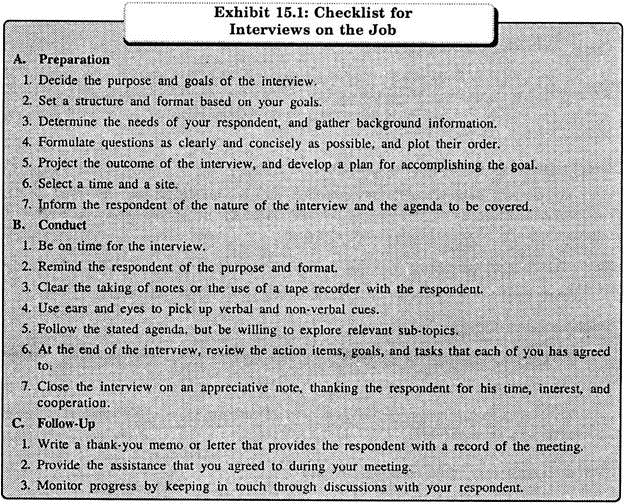This article throws light upon the three stages of conducting an interview. The stages are: 1. The Opening 2. Body 3. Closing.
Stage # 1. The Opening:
The opening is usually used to put the respondent at ease and to establish the purpose of the interview. To put the respondent at ease, the interviewer usually follows up the initial greeting with a brief informal conversation, helping the respondent to relax and building up a rapport with him.
Whatever the nature of the interview, the outcome is likely to be better when the interviewer and the respondent are comfortable with each other.
Once the respondent is made comfortable, the interviewer gives him a brief overview of what is to follow. He explains the purpose of the interview, what information will be needed, how it will be used and the general format of the interview. This sets the stage for the actual question-answer session that constitutes the body of the interview.
Stage # 2. Body:
ADVERTISEMENTS:
How the interviewer and the respondent handle their respective roles in this session is one of the most important deciding factors in shaping the final outcome.
The Interviewer’s Role:
It is the interviewer’s responsibility to control and focus the conversation so that the discussion doesn’t drift away from the agenda. At the same time he should be willing to explore relevant subtopics that might provide valuable insights into the situation or about the respondent.
The interviewer also has to ensure that he allots enough time to each item on the agenda. If he lingers too long on one topic, he may not have enough time to do justice to other areas that are equally important. Interviewers must listen actively in order to pick up verbal and non-verbal cues.
ADVERTISEMENTS:
Sometimes they are so caught up in framing their own questions and responses that they fail to hear what the respondent is actually saying. An alert interviewer must not only pay attention to the respondent’s verbal messages, but pick up non-verbal signals too, that may provide insights into the respondent’s behavior and attitudes.
Taking notes is sometimes advisable. However, if you intend to take notes, you must inform the respondent beforehand. Be brief and unobtrusive while taking notes. When a respondent is not totally responsive to a question, an interviewer may have to use probing questions to elicit a satisfactory response.
If a response is inadequate, you might say, that’s an interesting scheme. Can you give me more details? Skillful use of probing questions will improve your results.
Sometimes you can effectively use silence to induce the respondent to volunteer more details or a more satisfactory explanation. Summarizing the main points from time to time also helps to ensure that the interviewer and the respondent have the same understanding.
ADVERTISEMENTS:
The Respondent’s Role:
The respondent can do several things to ensure that he makes a favorable impression. The most important of these is to answer each question the interviewer asks as clearly and accurately as possible. A respondent who doesn’t give clear answers is either seen as having failed to understand the question or, as wanting to evade the issue.
Sometimes interviewers misinterpret facts. When this happens, it is up to the respondent to ensure that the record is set straight. He can do this by politely pointing out that he had said something else, or by unobtrusively repeating an earlier remark, so that the misunderstanding is cleared.
The respondent should also make sure that his answers are all tailored to achieving his purpose in attending the interview. The answers should be honest, but must always focus on the positive aspects.
Stage # 3. Closing:
Once the last question has been asked and answered, the interview can be rounded off by a restatement of conclusions. This signals that you have finished and gives the respondent an opportunity to ask relevant questions. The interviewer then gives the respondent some idea of what future action he can expect before concluding with pleasantries.
